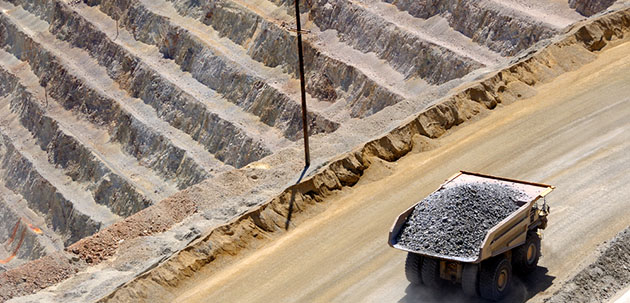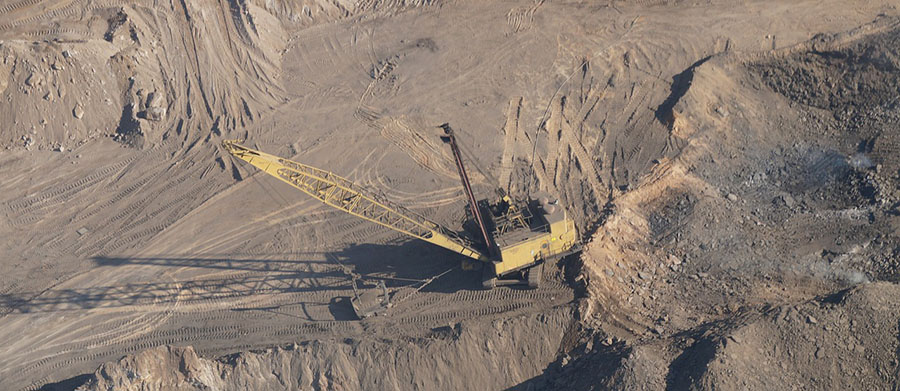Coal Stocks Are Historically Cheap—Here's What You Need to Know
Source: Patrick Vail, Money Morning (4/9/12)
"With a torrent of factors dragging the industry down, can coal make a comeback? Let's look at what's the matter with coal, why it doesn't matter in the big picture, and how you can make some money on the rebound."
The U.S. coal industry is facing a perfect storm and has taken a beating recently, bringing coal stocks down with it.
According to the Energy Information Administration (EIA), electricity generated by coal was down more than 20% in 2011. So it's no surprise that U.S. coal producers have been hit, and their valuations stand at 15-year lows.
With a torrent of factors dragging the industry down—from a bad reputation to dirt-cheap alternatives—can coal make a comeback?
Let's look at what's the matter with coal, why it doesn't matter in the big picture, and how you can make some money on the rebound.
What's the Matter with Coal Stocks?
There are three big reasons why coal has been beaten down:
First, a mild winter has curbed earnings of U.S. coal producers. Fourth-quarter earnings from both Peabody Energy Corp. (NYSE: BTU) and Arch Coal Inc. (NYSE: ACI) came in well below analyst expectations. Unseasonable warmth forced many producers to cut production, including ACI, Alpha Natural Resources Inc. (NYSE: ANR), and Patriot Coal Corp. (NYSE: PCX).
Second, domestic coal consumption has taken a huge hit due to increased regulation.
Just days ago, the Environmental Protection Agency (EPA) unveiled new Clean Air Act regulations limiting carbon emissions from newly built power plants, essentially banning new coal-fired power plants in the U.S.
While older power plants are exempt from the new regulations, many coal-fired power plants are being converted to run on cleaner natural gas, or even cleaner alternatives like biomass.
Third, hydraulic fracturing ("fracking") technologies have advanced over the past decade, making it very easy to extract large amounts of natural gas right here in North America. These new techniques work so well, in fact, that there is now an overabundance of natural gas in the marketplace. The production has far outpaced demand, and that's driving down the price.
The low price of natgas, in turn, is pushing down demand for coal, pushing down the price of coal, and pushing down the stock price of American coal producers.
But there's reason to believe the industry will rebound.
Here's Why It Doesn't Matter
While earnings have taken a hit over the mild winter, most producers have contracts to help them through leaner times without too much damage.
As more natgas power plants come online, and natgas exports increase (as they are set to), demand for natgas is going to rise, and the price will climb accordingly. That will leave coal once again as the cheaper alternative.
Peabody Chairman and CEO Gregory Boyce recently noted that, "coal has been the fastest-growing major global fuel and is expected to become the world's largest energy source."
Emerging markets in Asia are also set to provide a huge boost to the coal industry.
According to Money Morning Global Resource Specialist Peter Krauth, Editor of Real Asset Returns, "Global coal demand is likely to increase by over 200% in the next couple decades. That's not going to come from the developed world unless some technological breakthrough allows for much cleaner and more efficient burning of coal."
Among the world's top coal importers are countries like China, India, South Korea, and Taiwan.
As a result, U.S. coal producers are shifting more production to exports. In 2011, exports accounted for about 10% of U.S. coal production. This year production for export is already outpacing last year by 5% and that number is expected to climb steadily the next few years.
That trend will continue as American producers' ability to export coal to needy markets in Asia improves drastically over the next five years. Ports are already being developed on the West Coast to handle the increased volume.
Once the infrastructure is improved and production has shifted, American coal producers will benefit from increased global coal demand.
Three Ways to Play Coal Stocks (WLT, BTU, ARLP)
At historic lows, coal producers are a bargain.
While there's some risk in coal right now, Krauth thinks the stocks are financially sound. He says that, while coal stocks are languishing as a group, "most of them are profitable, and consensus earnings estimates the next couple of years are nearly 25% to 50% higher."
He cautions that investors might want to wait for an uptrend or other catalyst to make a move.
Here are stocks that will undoubtedly benefit when the industry rises.
Walter Energy Inc. (NYSE: WLT): Headquartered in Birmingham, AL, Walter Energy Inc. is one of the top metallurgical coal producers in the United States. In 2010, it sold 6 million metric tons and plans to expand sales to 8.5 million metric tons in 2013.
Unlike thermal coal, "met coal" isn't subject to pressures brought on by a mild winter. It typically escapes the ire of most environmental groups as a somewhat necessary evil and there's no viable alternative. Without met coal there is no other practical way to make the steel that emerging markets like China and India are using to build skyscrapers and improve their infrastructure at an incredible pace.
Currently trading at 60% off its 52-week high of $143.76, WLT will grow in tandem with emerging economies, not to mention the recovering economy here in the U.S. It's currently sporting a healthy P/E ratio of 10.25, and a one-year target price of around $79, which would be a 38% increase from where it's trading today.
Peabody Energy Corp. (NYSE: BTU): With a market cap of $8.05 billion, Peabody Energy Corp. is "the world's largest private sector coal company and the only global pure-play coal investment," according to Boyce.
BTU is also the largest producer in the U.S. based on revenue. Its Australian operations give it great exposure to Asian demand, and it produces both thermal and met coal. Rumors of a possible takeover have recently surfaced.
The company has a PEG of 0.93, which means it's undervalued given its expected growth. According to the company, that growth will be significant as the demand for steel and electricity generation in China and India continues to climb.
BTU is trading right around its 52-week low of $28.18, so there's plenty of room for the stock to run toward its target of around $47. BTU took a hit last week with the news out of the EPA, but with excellent financials and a global reach, BTU looks to move up.
Alliance Resource Partners LP (NASDAQ: ARLP) touts itself as the third largest coal producer in the Eastern U.S., with mining operations in Kentucky, Indiana, Illinois, West Virginia, and Maryland. By year end 2011, the company had $1.7 billion in assets and had generated $1.8 billion in total revenue.
The picture for ARLP looks much the same as it does for WLT and BTU: A solid P/E, a PEG below 1.0, and a one-year target price of about $84, which is 40% above where it's currently trading.
The big difference is that ARLP is a Master Limited Partnership (MLP), which means it avoids the corporate income tax at both the state and federal levels. The majority of its earnings are kicked back to limited partners (investors) in the form of quarterly required distributions (QRD).
The upshot is ARLP is yielding above 6%, earning investors a $3.96 dividend.
Patrick Vail
Money Morning
According to the Energy Information Administration (EIA), electricity generated by coal was down more than 20% in 2011. So it's no surprise that U.S. coal producers have been hit, and their valuations stand at 15-year lows.
With a torrent of factors dragging the industry down—from a bad reputation to dirt-cheap alternatives—can coal make a comeback?
Let's look at what's the matter with coal, why it doesn't matter in the big picture, and how you can make some money on the rebound.
What's the Matter with Coal Stocks?
There are three big reasons why coal has been beaten down:
First, a mild winter has curbed earnings of U.S. coal producers. Fourth-quarter earnings from both Peabody Energy Corp. (NYSE: BTU) and Arch Coal Inc. (NYSE: ACI) came in well below analyst expectations. Unseasonable warmth forced many producers to cut production, including ACI, Alpha Natural Resources Inc. (NYSE: ANR), and Patriot Coal Corp. (NYSE: PCX).
Second, domestic coal consumption has taken a huge hit due to increased regulation.
Just days ago, the Environmental Protection Agency (EPA) unveiled new Clean Air Act regulations limiting carbon emissions from newly built power plants, essentially banning new coal-fired power plants in the U.S.
While older power plants are exempt from the new regulations, many coal-fired power plants are being converted to run on cleaner natural gas, or even cleaner alternatives like biomass.
Third, hydraulic fracturing ("fracking") technologies have advanced over the past decade, making it very easy to extract large amounts of natural gas right here in North America. These new techniques work so well, in fact, that there is now an overabundance of natural gas in the marketplace. The production has far outpaced demand, and that's driving down the price.
The low price of natgas, in turn, is pushing down demand for coal, pushing down the price of coal, and pushing down the stock price of American coal producers.
But there's reason to believe the industry will rebound.
Here's Why It Doesn't Matter
While earnings have taken a hit over the mild winter, most producers have contracts to help them through leaner times without too much damage.
As more natgas power plants come online, and natgas exports increase (as they are set to), demand for natgas is going to rise, and the price will climb accordingly. That will leave coal once again as the cheaper alternative.
Peabody Chairman and CEO Gregory Boyce recently noted that, "coal has been the fastest-growing major global fuel and is expected to become the world's largest energy source."
Emerging markets in Asia are also set to provide a huge boost to the coal industry.
According to Money Morning Global Resource Specialist Peter Krauth, Editor of Real Asset Returns, "Global coal demand is likely to increase by over 200% in the next couple decades. That's not going to come from the developed world unless some technological breakthrough allows for much cleaner and more efficient burning of coal."
Among the world's top coal importers are countries like China, India, South Korea, and Taiwan.
As a result, U.S. coal producers are shifting more production to exports. In 2011, exports accounted for about 10% of U.S. coal production. This year production for export is already outpacing last year by 5% and that number is expected to climb steadily the next few years.
That trend will continue as American producers' ability to export coal to needy markets in Asia improves drastically over the next five years. Ports are already being developed on the West Coast to handle the increased volume.
Once the infrastructure is improved and production has shifted, American coal producers will benefit from increased global coal demand.
Three Ways to Play Coal Stocks (WLT, BTU, ARLP)
At historic lows, coal producers are a bargain.
While there's some risk in coal right now, Krauth thinks the stocks are financially sound. He says that, while coal stocks are languishing as a group, "most of them are profitable, and consensus earnings estimates the next couple of years are nearly 25% to 50% higher."
He cautions that investors might want to wait for an uptrend or other catalyst to make a move.
Here are stocks that will undoubtedly benefit when the industry rises.
Walter Energy Inc. (NYSE: WLT): Headquartered in Birmingham, AL, Walter Energy Inc. is one of the top metallurgical coal producers in the United States. In 2010, it sold 6 million metric tons and plans to expand sales to 8.5 million metric tons in 2013.
Unlike thermal coal, "met coal" isn't subject to pressures brought on by a mild winter. It typically escapes the ire of most environmental groups as a somewhat necessary evil and there's no viable alternative. Without met coal there is no other practical way to make the steel that emerging markets like China and India are using to build skyscrapers and improve their infrastructure at an incredible pace.
Currently trading at 60% off its 52-week high of $143.76, WLT will grow in tandem with emerging economies, not to mention the recovering economy here in the U.S. It's currently sporting a healthy P/E ratio of 10.25, and a one-year target price of around $79, which would be a 38% increase from where it's trading today.
Peabody Energy Corp. (NYSE: BTU): With a market cap of $8.05 billion, Peabody Energy Corp. is "the world's largest private sector coal company and the only global pure-play coal investment," according to Boyce.
BTU is also the largest producer in the U.S. based on revenue. Its Australian operations give it great exposure to Asian demand, and it produces both thermal and met coal. Rumors of a possible takeover have recently surfaced.
The company has a PEG of 0.93, which means it's undervalued given its expected growth. According to the company, that growth will be significant as the demand for steel and electricity generation in China and India continues to climb.
BTU is trading right around its 52-week low of $28.18, so there's plenty of room for the stock to run toward its target of around $47. BTU took a hit last week with the news out of the EPA, but with excellent financials and a global reach, BTU looks to move up.
Alliance Resource Partners LP (NASDAQ: ARLP) touts itself as the third largest coal producer in the Eastern U.S., with mining operations in Kentucky, Indiana, Illinois, West Virginia, and Maryland. By year end 2011, the company had $1.7 billion in assets and had generated $1.8 billion in total revenue.
The picture for ARLP looks much the same as it does for WLT and BTU: A solid P/E, a PEG below 1.0, and a one-year target price of about $84, which is 40% above where it's currently trading.
The big difference is that ARLP is a Master Limited Partnership (MLP), which means it avoids the corporate income tax at both the state and federal levels. The majority of its earnings are kicked back to limited partners (investors) in the form of quarterly required distributions (QRD).
The upshot is ARLP is yielding above 6%, earning investors a $3.96 dividend.
Patrick Vail
Money Morning

























































